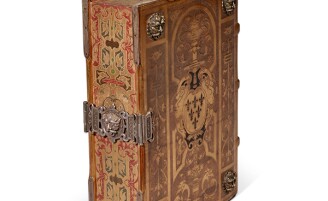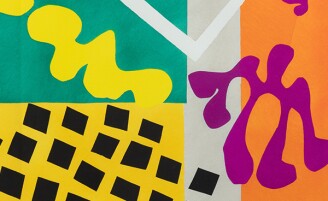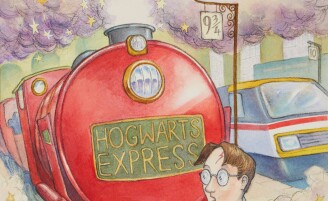Pictures on Pages
.
A picture paints a thousand words, right? But what about a picture surrounded by a thousand words? Well, that’s the stuff of mysteries and myths and childhood dreams. For centuries, book illustrations have put a face to the names of classic characters.
Winnie-the-Pooh and Sherlock Holmes became visually, as well as imaginatively, enlivened by the illustrative magic of E.H. Shepherd and Sidney Paget. Through their art, readers could see what the bear was up to in the Hundred Acre Wood and follow the world’s most famous sleuth down Baker Street. Writing sews seeds and illustrations water them, a fertile literary tradition that has endured for centuries.
This summer, Sotheby’s Fine Books & Manuscripts sales in New York, London and Paris, offer an array of literary treasures – from the 13th century to the present day – that also celebrate a gallery of marvellous and inventive visual interpretations by artists from Leonardo da Vinci to Henri Matisse. It also introduces us – in a swirl of railway steam – to a young wizard named Harry Potter.

The earliest illustrated volumes offered are, understandably, either religious or of a scholarly scientific nature. A 13th-century illuminated English Bible, painted by the Sarum Master, arrives with a remarkable provenance, having been formerly in the collections of both J. Paul Getty and Ernst Boehlen. Also from the Boehlen Collection, comes an illuminated early 15th century vellum manuscript of a historiated initial depicting the Annunciation, painted by Cristoforo Cortese.

The more visceral aspects of the human body can be found in De Humani Corporis fabrica libri septem (the Royal Institution copy of Andreas Vesalius’ epochal publication from the mid-16th century, described as “one of the most beautiful scientific books ever printed”). Here, readers can survey the inner workings of bones, muscles, cartilages and arteries.
More gruesome details can be found in a 13th century collection of cautery drawings from an Italian medical manuscript. However, more genteel material resides in the pages of Venetian lace pattern books, with their woodcut illustrations of women engaged in needlework.

From the sewing room to the studio for Leonardo da Vinci, Trattato della pittura, the master of masters' great treatise on painting. Appearing at Sotheby’s London is the only pre-publication manuscript copy of the work that contains small sketches, known as Urbinate drawings, and copies of Poussin's illustrations.
Another extraordinary find is the Rothschild copy of William Blake’s Songs of Innocence and of Experience, printed by William Blake, and colored by William and Catherine Blake. Of the handful of copies created during Blake’s lifetime that remain in private hands, this is the first to appear at auction since 1989. In Blake, we find a poet, painter and printmaker working his various talents in harmony to produce a collection of illustrated poems on the passage from childhood innocence to the realities of adult life.

La Nouvelle Chute de l’Amérique saw Pop Art giant Roy Lichtenstein, arguably one of the most significant figures of the movement, join forces with Beat poet Allen Ginsberg in a collaboration that addresses the political and social turmoil of America in the 1970s. Both Lichtenstein and Ginsberg were acutely aware of the national mood in a country reeling from the aftershocks of the Vietnam war, and increasing racial tensions throughout the United States. Employing Lichtenstein’s trademark comic book motifs and the iconic Ben-Day dots, the images (10 original colour etchings and aquatints) boldly depict themes of industry, landscape, identity and religion present in Ginsberg’s commentary.
Elsewhere in the Livres et Manuscrits sale in Paris, an original gouache drawing in the artist's own hand brings to life Salvador Dalí's La Femme Visible from 1930, and Louise Bourgeois's deeply personal Ode à ma mère, which sees the artist revisiting the spider motif (intrinsically linked to her relationship with her mother) that appears throughout her work, from large-scale sculptural interventions to the delicate dry-point etchings and poetry we see here.

Modern readers have particularly enjoyed the artistic potential of music and mayhem (along, of course, with a few cute pets). With Jazz (1947), Henri Matisse created one of the most spectacular art books in history, including 20 exceptional pochoirs – a fine limited-edition stencil process – of swimmers and sword swallowers, all created from cut-outs made while the artist was bedbound in his final years.
Kathleen Hale, the author and illustrator of Orlando, the Marmalade Cat, delivers a charming illustration of kittens at the opera, while in a presentation copy of The Wonderful Wizard of Oz, we find Dorothy rescuing Toto from the howling winds of a hurricane, captured in W.W. Denslow’s acid-bright artwork. Elsewhere, we find the fairy tale imaginations of Arthur Rackham and Edmund Dulac, with examples from the “Golden Age” of illustration.
There is both life and death on view in these books. Sidney Paget’s original pen and ink and wash drawing of The Death of Sherlock Holmes for Arthur Conan Doyle’s short story The Final Problem shows us the demise of the brilliant consulting detective, as he tumbles from the Reichenbach Falls. Or does it?

Meanwhile, an origin story of an icon can be found in Thomas Taylor’s watercolor for the cover of Harry Potter and the Philosopher’s Stone, J.K. Rowling’s runaway bestseller. Taylor’s image of the bespectacled novice wizard heading off to Hogwarts from Platform 9 ¾ at Kings Cross Station, set millions of readers – and Harry – on a journey like no other.
All of these remarkable volumes highlight a kind of collaborative alchemy. While an author opens a window, an illustrator shows you the view.

















